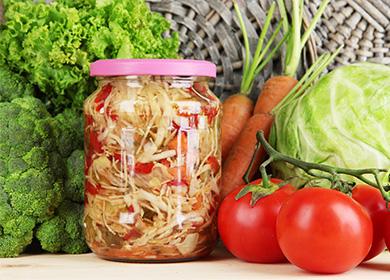Cabbage has long and reliably entered the diet of our compatriots. Back in 1076, the “Svyatoslav Izbornik” compiled in Kievan Rus included a section on the rules for the preparation and storage of white cabbage with a description of substances valuable to the body. However, it is not worth abusing a useful vegetable during an exacerbation of diseases of the digestive system, intestinal and gastric bleeding, increased intestinal motility, enterocolitis, pancreatitis. Excessive consumption of cabbage is also fraught with flatulence.
About the benefits
You can stock up on canned salad for the winter, made not only from white cabbage, but also from other types of vegetables: red-headed, Savoy, Beijing, Brussels, cauliflower, broccoli and kohlrabi. In composition, all varieties are similar, their concentration is different. The table below reflects the main substances and their benefits to the body.
Table - The benefits of cabbage
| Component | Beneficial features |
|---|---|
| Beta carotene | - Improves visual function; - provides an antioxidant effect; - participates in the synthesis of protein compounds; - accelerates regeneration |
| Vitamin B2 | - Serves metabolic processes; - increases immunity; - necessary for the full functioning of the nervous system; - improves visual acuity, prevents the development of cataracts; - accelerates regeneration |
| Vitamin B6 | - Participates in the metabolism of proteins and lipids; - provides a diuretic effect; - Serves the synthesis and operation of many enzymes; - regulates blood glucose |
| Vitamin B9 | - Participates in the synthesis of hemoglobin; - supports the immune system; - serves the work of the hematopoietic system; - necessary for the normal course of pregnancy |
| Vitamin C | - Serves redox reactions; - blocks inflammatory processes; - strengthens the immune system; - improves iron absorption |
| Vitamin K | - Regulates blood coagulation; - necessary for the work of the liver, kidneys, gall bladder; - normalizes blood coagulation; - Serves the processes of metabolism in the connective and bone tissues; - neutralizes some poisons |
| Vitamin PP | - It shows vasodilating properties; - participates in redox processes; - serves the metabolism; - normalizes the function of the nervous system; - regulates blood cholesterol |
| Vitamin U | - It has healing properties: heals wounds, ulcers, erosion; - lowers cholesterol |
| Potassium | - Normalizes the water-salt balance; - regulates heart rhythms, blood pressure; - participates in nerve impulses |
| Calcium | - Participates in the work of the neuromuscular system; - stimulates the work of certain enzymes; - has an anti-inflammatory effect; - is an antiallergen |
| Cobalt | - Stimulates lipid metabolism, folic acid metabolism; - Serves protein synthesis, including DNA; - activates metabolic processes; - stimulates the production of red blood cells; - supports pancreatic function |
| Manganese | - Supports blood glucose; - accelerates lipid metabolism; - normalizes the condition of bone and connective tissue; - improves brain and nervous system |
| Copper | - Participates in the conversion of iron to hemoglobin; - Serves the production of elastin and collagen |
| Phosphorus | - Supports the structure and function of the nervous system; - strengthens teeth and bones; - increases brain activity; - participates in the work of the heart, kidneys, muscles; - serves metabolic processes |
| Vegetable proteins | They are the basis for building body cells |
| Cellulose | - Removes toxins from the body; - activates intestinal motility |
| Tartronic acid | - Blocks the conversion of protein compounds into fats; - prevents fermentation processes; - improves digestion |
| Volatile | Have an antibiotic effect |
The choice of the main ingredient
Autumn or winter varieties are suitable for harvesting: salads are juicy and crispy. Summer cabbage is not suitable for home preservation. Most preferred for blanks: Zavodskaya, Biryuchekutskaya 138, Dobrovodskaya, Kupchikha, Belorusskaya 455, Kolobok, Atria F1, Megaton F1.
When choosing white cabbage and other types of cabbage, you need to take fruits without signs of decay and mold. Withered vegetables cannot be used: they are devoid of the juiciness necessary for tasty preservation.
Conservation Methods
Preservation of products for a long period by conservation is achieved using acids that inhibit the growth of rotting bacteria. Acids can be introduced into a conserved product (vinegar), or formed as a result of the activity of beneficial microorganisms (lactic acid). The following table gives an overview of conservation methods and their features.
Table - Methods of harvesting cabbage
| Method | Preservatives | Features |
|---|---|---|
| Souring | Lactic acid | - The most “useful” way: most valuable substances are preserved; - the conservation process is long; - no sterilization required |
| Salting | - salt; - lactic acid | - A large amount of salt can drown the taste of the workpiece; - the cooking process is long; - salty foods are contraindicated in diseases of the stomach and intestines; - no sterilization required |
| Pickling | - Vinegar; - vegetable oil | - Allows you to quickly get the finished product; - the salad is obtained with a characteristic sourness; - vinegar is contraindicated for problems with the digestive system |
Sterilization
Sterilization is an important point in home preservation. The elimination of unnecessary bacteria that provoke fermentation and damage to the workpiece will increase the shelf life of the salad.
The workpiece is distributed in glass jars pre-sterilized in a steam bath, oven or multicooker. It is better to boil the lids for 10-15 minutes, or at least scald with boiling water. Salting and pickling can be carried out in wooden barrels or large enameled containers. In this case, the vessel must first be washed with soda or laundry soap.
If the salad is prepared by pickling, an additional two-stage sterilization of the workpieces is required.
- In the steam bath. At the bottom of a large pan, lay a linen or cotton towel folded in several layers. Distribute the workpiece on the banks and cover with lids, but do not close. Place the containers in the pan and pour so much water into the vessel so that it hides the cans “by the shoulders”. Put on fire, wait for boiling, reduce flame and detect time.Half-liter containers are sterilized for 20-25 minutes, liter - 25-30 minutes, two- and three-liter - 35-40 minutes. Banks roll up. In some recipes, this process is replaced by a long (half an hour) stewing of the vegetable mixture.
- Passive. After seaming, place the cans on a pallet or baking sheet, turning upside down. Wrap in a blanket and wait a day until it cools completely. Transfer workpieces cool for permanent storage.
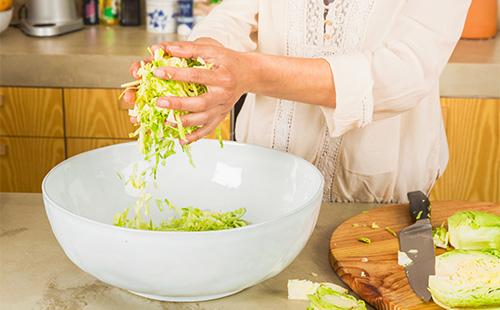
Coleslaw for the winter: 10 recipes
Choosing the right recipe does not necessarily follow you step by step. You can include additional ingredients in the snack or experiment with spices. However, the correction of the proportions of the components of the marinade is unacceptable, otherwise the salad will not work for a long time. The same applies to the amount of sugar and salt during pickling and salting.
Base
Features In this way, you can make a salad of white or red cabbage. However, if you take a purple vegetable, you need to remember that the juice in its leaves is much less, so it is better to use the product, mixing in arbitrary proportions with white.
Components:
- cabbage - 2 kg;
- carrots - one fruit;
- salt - 40 g;
- laurel and peppercorns to taste.
Technology
- Cut carrots and cabbage into narrow strips.
- Fold in an enameled container, salt, mashing the vegetable with your hands, so that the juice comes out.
- Enter finely broken laurel, pepper.
- Arrange in banks, leaving free space for liquid to exit.
- Place the containers on a pallet, stand at room temperature for two to three days. Pierce the vegetable mixture once or twice a day with a wooden stick to ensure the release of gases. When the foam and turbid water disappear, fermentation is completed.
- Close the cans with lids and stand for 24 hours in the refrigerator.
Pickle
Features As spices, you can use any spices to taste, most often added cumin and dill seeds.
Components:
- white cabbage - 3 kg;
- carrots - 400 g;
- water - 2.5 l;
- salt - five large spoons;
- sugar - three large spoons;
- pepper and spices to taste.
Technology
- Chop vegetables, mix, rinse.
- Distribute into jars, tamp, introduce spices.
- Boil water, add sugar and salt, after one to two minutes remove from the stove.
- After waiting 10-15 minutes, pour the composition in a container with salad, cover the banks folded with several layers of gauze.
- To sustain at room temperature two days, twice a day "piercing" the mass with a stick.
- Drain the brine from the cans into the pan, boil, wait for cooling.
- Pour into containers with vegetables, close the lids. To sue.
- Soak in the refrigerator for three days.
With mushrooms
Features In culinary forums, such a salad with cabbage for the winter is called "Autumn." Forest mushrooms are used, champignons and oyster mushrooms will also work.
Components:
- white cabbage and mushrooms - 2 kg each;
- carrots and onions - 1 kg each;
- vegetable oil - 0.5 l;
- vinegar 9% - 300 ml;
- sugar - seven large spoons;
- salt - three large spoons.
Technology
- Boil mushrooms in salted water until tender, rinse with cool water.
- Chop the onion, chop the remaining vegetables.
- Spasser onion and carrot until translucent.
- Introduce mushrooms, cabbage, pour oil.
- Wait for boiling, reduce the heat and simmer the mixture under the lid for half an hour.
- Introduce sugar, salt, vinegar and continue stewing for another 30-40 minutes.
- Distribute to banks, roll up.
With mixed vegetables and spices
Features In narrow circles, this preparation is called coleslaw “You'll lick your fingers” for the winter. The number and composition of spices can be adjusted depending on taste preferences. Instead of Bulgarian Hungarian purple pepper will do.
Components:
- white cabbage - head of cabbage;
- onions and Bulgarian pepper - four each;
- carrots - three;
- garlic - two cloves;
- water - 2 l;
- vinegar 9% - 100 ml;
- sugar - 90 g;
- salt is a big spoon;
- grated root, ground hot pepper and juniper berries - a pinch;
- grains of mustard and coriander, ground dried dill - on a small spoon.
Technology
- Cut carrots, cabbage, pepper into strips, cut the onion into cubes or half rings.
- Mix vegetables with salt, mash hands.
- Boil water, mix vinegar, salt, sugar, crushed spices in a mortar.
- Pour the composition into a container with vegetables, cover with gauze. Keep at room temperature for a couple of days.
- Arrange the salad in containers, fill with marinade.
- Sterilize, clog.
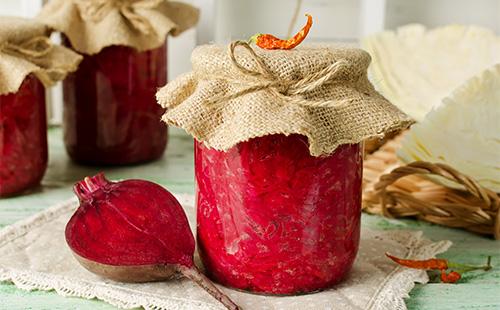
In Korean
Features Beijing cabbage is harvested in this way. The workpiece is characterized by an oriental spicy taste and aroma.
Components:
- cabbage - 2 kg;
- carrots - 0.5 kg;
- garlic - two heads;
- water - 1 l;
- odorless vegetable oil - 200 ml;
- vinegar 9% - a large spoon;
- sugar - 200 g;
- salt - three large spoons;
- laurel - three leaves;
- hot ground pepper - half a small spoon.
Technology
- Cabbage, carrots chopped in a thin strip, chop the garlic. Stir, put in jars.
- Boil water, add oil, vinegar, salt, sugar, spices. After one or two minutes, remove from the burner.
- Fill containers with blanks.
- Sterilize, clog.
In Georgian
Features Traditionally, cauliflower or white cabbage is used for harvesting in Georgian, but the vegetable can be replaced with kohlrabi. The total amount of water and salt can be different, most importantly, observe the proportion: two tablespoons per liter.
Components:
- cabbage - 4 kg;
- carrots - 1.5 kg;
- beets - three fruits;
- garlic - two heads;
- hot pepper - two pods (or less, to taste);
- horseradish root - one piece;
- parsley, cilantro, dill - in a bunch;
- laurel - ten sheets;
- peppercorns - eight to ten.
Technology
- Chop cabbage, carrots, chop garlic into plates, beets - large cubes.
- Grind greens, divide the pepper into a couple of parts.
- In a pan, or even better in an oak tub, lay out the products in layers in random order, pouring spices.
- Heat the water to a boil, add salt.
- Pour the brine so that the liquid covers the mixture.
- Press and hold for two to five days at room temperature.
- Set in the cold for a week.
- Leave to be stored in brine or distribute to banks.
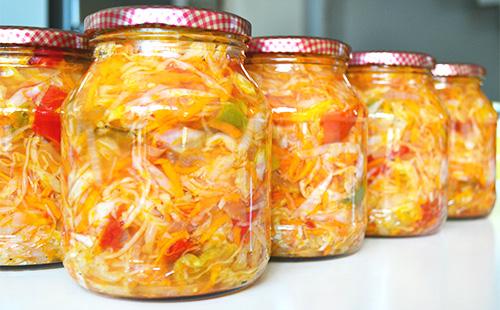
With bell pepper
Features The recipe describes a winter salad with brussels sprouts. Fruits are desirable to choose a small size.
Components:
- cabbage - 1.5 kg;
- Bulgarian pepper - 400 g;
- onions - six small heads;
- water - 2 l;
- sugar - two large spoons;
- salt is a big spoon;
- hot pepper - one pod;
- laurel - two or three leaves;
- pepper peas - five pieces.
Technology
- Halve the cabbage and onions, cut the carrots into round plates, and the pepper into squares.
- Arrange vegetables in banks, placing cabbage on top.
- Boil water, add salt and sugar, spices.After two minutes, turn off the gas.
- "Bouillon" pour into banks.
- Sterilize blanks, roll up.
With eggplant
Features This cabbage salad in jars for the winter looks very impressive and can be served as an independent snack or as a side dish for meat dishes.
Components:
- eggplant - 3 kg;
- white cabbage - 2 kg;
- onions, carrots, Bulgarian pepper - 500 g each;
- garlic - 300 g;
- hot pepper - one or two pods;
- vegetable oil - 500-600 ml;
- vinegar essence - two large spoons;
- salt at the discretion of the cook.
Technology
- Chop the eggplants with thin bars, boil in salted water for about five to seven minutes, rinse, squeeze.
- Chop onion in half rings, pepper in a strip, chop cabbage, carrots.
- Process garlic, hot pepper with a meat grinder.
- Combine vegetables with spicy mixture, add vinegar, salt.
- Heat the oil to a boil and pour into the total mass.
- Distribute to banks, sterilize, roll up.
With tomatoes
Features It is advisable to take plum-like tomatoes: such fruits are dense and retain their shape better during conservation. You can use an equal amount of tomato paste instead of tomatoes, then the consistency of the workpiece will turn out different.
Components:
- white cabbage - 3 kg;
- tomatoes, sweet pepper - 2 kg each;
- carrots, onions - 1 kg each;
- vinegar 9% and vegetable oil - in a glass;
- sugar - six large spoons;
- salt - eight small spoons.
Technology
- Chop the tomatoes into slices, pepper, onion - a strip, carrots, chop cabbage.
- Introduce vinegar, oil, sugar, salt into the vegetable mass.
- Insist for two hours, without cleaning in the cold.
- Boil the mixture, simmer over low heat for 20-30 minutes. You can also prepare a salad in the slow cooker by installing the “Stewing” program.
- Distribute to banks, roll up.
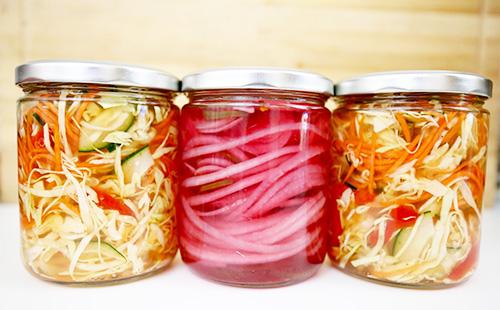
Kuban
Features The recipe is taken from the book "Kuban classrooms." The appetizer is a full-fledged vegetable salad.
Components:
- white cabbage, cucumbers, tomatoes, bell pepper - 1.5 kg each;
- onions, carrots - 1 kg each;
- parsley, dill - in a bunch;
- vinegar 9% - a glass;
- vegetable oil - one and a half to two glasses;
- allspice - 20-30 peas;
- laurel - six sheets;
- sugar - six large spoons;
- salt - three large spoons.
Technology
- Grind carrots, cabbage, pepper into a thin strip, cucumbers, tomatoes, onions - in half rings.
- Chop greens.
- Combine the components with salt, pepper, sugar, vinegar.
- Insist an hour or two so that the juice comes out.
- Boil, simmer on medium flame for 20 minutes. Five minutes before the readiness to enter a broken laurel.
- Distribute to banks, roll up.
Each housewife has a favorite cabbage salad recipe for the winter. But regardless of the cooking method, the workpiece always turns out delicious. The dish is served as an independent snack or “in company” with boiled and fried potatoes, fresh vegetables, rice and other friable cereals.
